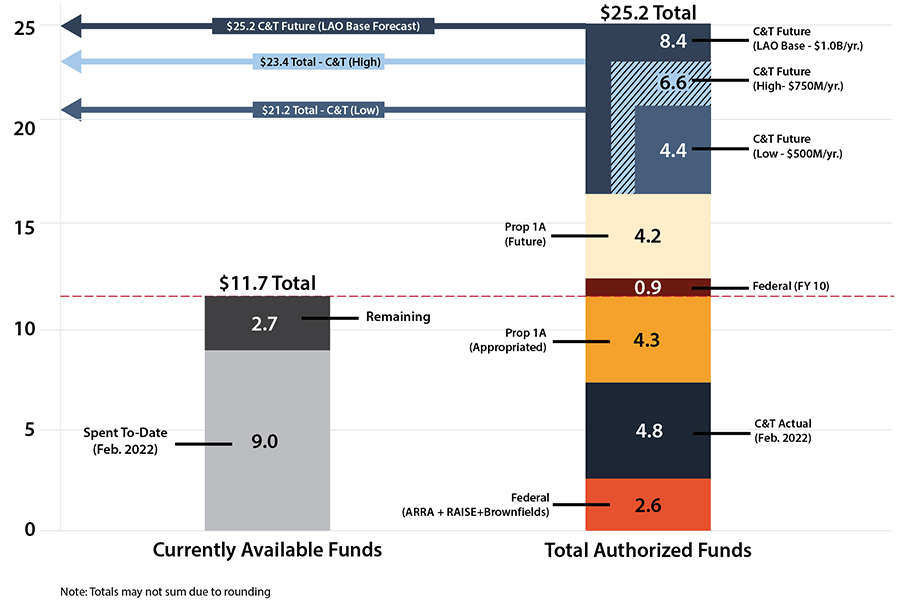Highlights from Chapter 3:
Funding the Program
There are significant new funding opportunities for the program stemming from the federal Bipartisan Infrastructure Law, as well as a range of other programs that could provide long-term sources of revenue to fund the construction of future project sections. Governor Newsom emphasized the state’s commitment to clean transportation investments by proposing almost $15 billion in his budget for programs and projects that align with climate goals, advance public health and equity, and improve access to opportunity. These additional state funds will competitively position California to pursue federal funds.
This chapter provides an update of the sources of funds that are currently available to the Authority, as well as discusses funding sources that the Authority has identified, but not secured, to progress construction of the program in all regions of the state.
Currently Available and Authorized Funding

Text description of Currently Available and Authorized Funding
Overview
This chart provides an overview of the current and projected funding available to the Program through 2030. It provides a summary overview and component elements of the available funding. The total amount of identified revenue for the capital program is currently estimated in the range of $21.2 billion to $25.2 billion, with a medium forecast of $23.4 billion. The medium forecast is based on a dynamic Cap-and-Trade market that best matches historical performance of the auctions. The ultimate amount will depend on Cap-and-Trade auction proceeds received through 2030.
$11.7 billion in currently available funds includes $9.0 billion spent to date (February 2022) and $2.7 billion remaining. $25.2 billion in total authorized funds includes $2.6 billion in Federal ARRA and RAISE, $4.8 billion Cap-and-Trade actual as of February 2022, $4.3 billion in Prop 1A appropriated funds, $0.9 billion federal FY10 grants, $4.2 billion Prop 1A future funds, and between $4.4 billion and $8.4 billion in Cap-and-Trade future funds.
Key Facts
In line with the Governor’s 2022 Budget, the 2022 Business Plan recommends $4.2 billion in bond funds be appropriated to complete delivery of the 119-mile Central Valley Segment
The last four Cap-and-Trade auctions have yielded more than $1 billion in Cap-and-Trade total revenues for the Authority, a strong recovery from recent COVID-19 pandemic induced market volatility
The passage of the Bipartisan Infrastructure Law heralds the beginning of a sustained federal-state partnership in the development of California’s high-speed rail program
Bipartisan Infrastructure Law Grant Programs ($ in Billions)
| COMPETITIVE GRANTS PROGRAM | ELIGIBILITY/PURPOSE | APPROPRIATED | ADDITIONAL AUTHORIZATION | TOTAL |
|---|---|---|---|---|
| Federal-State Partnership for Intercity Passenger Rail Grants (F-S PIPR) (excluding the Northeast Corridor set-aside) | High-speed rail and all intercity rail expansion projects Multi-year commitments possible | $12.0 | $4.1 | $16.1 |
| Consolidated Rail Infrastructure and Safety Improvements (CRISI) | Capital projects that will improve passenger and freight rail transportation systems in terms of safety, efficiency, or reliability | $5.0 | $5.0 | $10.0 |
| National Infrastructure Project Assistance Program (NIPA) (Megaprojects) | Broad eligibility for different types of infrastructure | $5.0 | $10.0 | $15.0 |
| Local and Regional Project Assistance Program (L&R) (RAISE Grants) | Invest in roads, rail, transit and port projects to achieve national objectives | $7.5 | $7.5 | $15.0 |
| Nationally Significant Multimodal Freight and Highway Projects (INFRA Grants) | Fund highway and freight projects of national and regional significance Available for rail/highway crossing projects | $3.2 | $6.0 (Authorization) and $4.8 (Contract Authority) | $14.0 |
| Federal Railroad Administration Railroad Crossing Elimination Program | Highway-rail grade crossing improvement projects that focus on improving the safety and mobility of people and goods | $3.0 | $2.5 | $5.5 |
Key to Terms: Appropriated – Funds are appropriated in the legislation. Authorized – Funds can only be released upon future appropriation by Congress. Contract Authority – Funds come from the Highway Trust Fund and do not require appropriations to be released.

